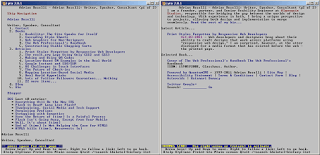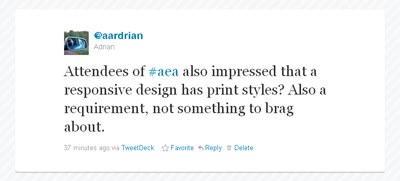Test in Lynx and Print, It’s Your Job
I have admittedly not taken the time to attend An Event Apart any of the times it’s been held, but I do tend to follow the #aea hashtag on Twitter so I can glean at least a little wisdom from the discomfort of my own desk as I wade through more mundane tasks.
That means I sometimes see tweets like the one below which, taken out of context, get my blood boiling:
I try hard not to Tweet in anger, but sometimes they slip out:
I had just this morning been taking time to review my own site in Lynx after a minor update, as I do after every update, just to make sure my alt text, page structure, content, navigation, etc. were all working the way they should. Lynx is part of my regular testing suite. It also helps remind me that reliance on JavaScript for things that can be handled on the server or with CSS isn’t such a good idea.
I can’t imagine a testing process that doesn’t include Lynx. Lynx is the truly lowest common denominator on the web. It gives you insight into how a page is structured, how assistive technology will approach it, and even how search engines will perceive it.
In addition to testing in Lynx, I always look at how a page prints. I create a PDF from a handful of browsers for every project, targeting the home page, content pages, and some outliers (odd templates, gallery chaos, JavaScript flim-flam, and so on). I think that should be expected of all web developers, though clearly it is not. This particular issue has frustrated me more than once, as I outline in my posts Print Styles Forgotten by Responsive Web Developers and More Samples of Responsive Web Design ≠ Print.
Add together my beliefs about Lynx support and print styles, and I cannot accept that anyone would consider this to be something more than the most basic standard practice. Do we get excited when our pages validate? When we choose the right element? Do we celebrate when Twitter pushes out one of our tweets? When Google Analytics produces a chart? When my email gets to its destination? No, because these are basics we should expect.
Let’s stop setting the bar so low and expect more of ourselves as developers. Until we do that we aren’t professionals, we’re hobbyists. Ego-driven hobbyists.
By the way, in addition to that screen shot of my site in Lynx (starting this post), here’s my site when printed:





Leave a Comment or Response